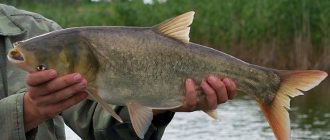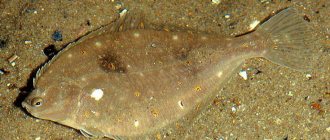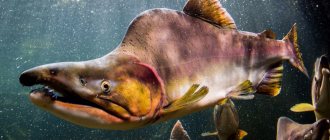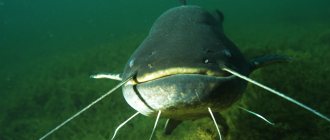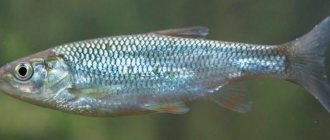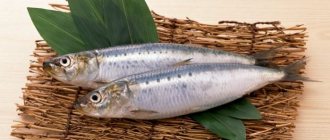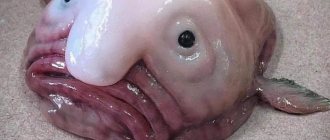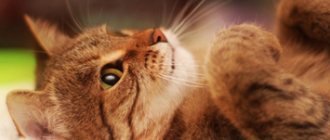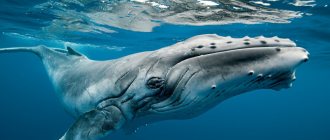Flounder
- a sea fish that belongs to the flounder family. The strongly flattened body, as well as the eyes located on one side of the fish, are its two most important differences. The eyes are most often on the right side. The body of the flounder is asymmetrical with a double color: the side with the eyes is dark brown with an orange-yellowish spot, and the “blind” side is white, rough with dark spots. Flounder feeds on crustaceans and bottom fish. In commercial catches, its average length reaches 35-40 cm. The fertility of adult flounder is from hundreds of thousands to ten million eggs.
Description
Flounder fish
All flounders have a flat body. The lower part is one of the sides of the fish that has moved as a result of undergoing metamorphosis, which is characteristic of all flatfishes. The lower part can be compared to sandpaper: it is very rough from constant contact with the bottom of the reservoir, there are no eyes here. The eye on this side moves to the other, since it is bad to observe what is happening with one eye.
The upper part of the fish contains the pectoral fins. There is also an eye that has moved from the bottom side. Flounder has a pigment that allows it to imitate any surface. This is necessary for the fish in order to hide at the bottom from predators who like to feast on it. If you put a flounder on a chessboard, then light and dark spots will certainly appear on the top, like on the board.
Varieties
There are two main types of flounder: river flounder and sea flounder. Externally, the fish are very similar to each other, but they may differ in size and body weight. There is a wide variety of flounder species within the genus, but the largest one is caught at sea. She weighed more than a hundredweight, and her body length was 2 meters. River flounder grows up to 50 centimeters and reaches a weight of 2 kilograms, and sea flounder grows up to 60 centimeters and weighs 7 kilograms. But in the photo they look about the same.
Of course, everyone who sees this type of fish for the first time is interested in the question: why is flounder flat? This is necessary in order to lead a benthic lifestyle and burrow into the soil as much as possible, imitating its structure, otherwise the fish will serve as food for predators. The young flounder swims vertically, and its appearance is normal, familiar to us. However, as the fish grows older, it undergoes a metamorphosis, and it already swims sideways, and all parts of the body are displaced for a more convenient existence.
Natural enemies
Despite the first-class camouflage skill, the fish is forced to flee and beware of other inhabitants of rivers and seas. These ill-wishers attack flounder or destroy the eggs that the fish diligently lay.
Ichthyologists have identified a list of enemies that pose a danger to ray-finned fish:
- acne;
- shark;
- Human;
- halibuts.
In the spring, a female flounder lays up to 10 million eggs. Young fish are distinguished by the absence of characteristic asymmetry and swim sideways. They are naive and defenseless, so in most cases they become prey for individuals of other species.
Distribution and habitats
Marine and river flounder species have different habitats.
Marine fish live mainly in the waters of the Atlantic Ocean. But it is also common in the White, Northern and Okhotsk Seas. River flounder can live both in the sea and in rivers, where they can swim quite far. This fish lives in the Black and Mediterranean Seas, in the rivers flowing into them, as well as in the Yenisei. There is even a special type of flounder: Black Sea flounder. Varieties of flounder
Black Sea flounder is a valuable commercial fish that fishermen love to hunt. Black Sea flounder, like any other, prefers to lead a bottom-dwelling lifestyle. It is preferable for her that the soil be loose enough to burrow into it easily. But thanks to the ability of mimicry, this is not so important: how many colored stones there are on the bottom, the number of colors will be conveyed by the upper surface of the fish.
Commercial value
Flounder is valuable to all anglers. Connoisseurs value saltwater fish more because they reach larger sizes compared to their counterparts from river reservoirs.
In the 1980s, global catches exceeded 200 thousand tons, but in the 21st century they dropped to 100 thousand tons. The Netherlands and Denmark are world leaders in archery fishing.
About 5 thousand tons of flounder are caught in Russia every year. They are usually caught using bottom trawls or snares. The market readily sells halibut and other varieties of flounder that live at a depth of 50-200 m in the seas. These individuals are valuable due to their meatiness and a huge number of useful components.
Habits
It doesn’t matter whether the flounder is freshwater or saltwater, all representatives of this family are very poor swimmers. Sensing danger, the fish turn over on their edge and quickly swim away in this position. As soon as the danger has passed, they sink back to the ground and burrow.
Depending on where the flounder lives, it is capable of changing its color at lightning speed, acquiring the desired shade. The color of the fish depends primarily on the color of the seabed and its pattern. When changing, flounder achieves such colors as to be practically invisible. This kind of adaptability is called mimicry. But not all representatives of this genus have this property, but only those that see. Having lost its sight, the fish will no longer be able to change the color of its body.
Flounder is a sea fish whose size ranges from a few grams to three hundred kilograms. Its weight and size depend primarily on the type. Some individuals reach four meters in length. Many of us have heard of halibut, but everyone knows that it is flounder. What kind of fish - river or sea - is certainly not known to many. Meanwhile, halibuts are the largest flounder that live in the Pacific and Atlantic oceans. A fish weighing 363 kilograms was recorded, and this is the largest value known to science. An interesting fact is that this species of flounder can live up to fifty years of age. In addition, flounder is a valuable marine commercial fish.
Appearance
A flat body is the result of centuries-old transformations. Her fry are the same as most fish. But as they grow older, they begin to “flatten out” - this is how genes work. The mouth of the flounder, about which legends are made, does not move to the other side and has a curved appearance. The displaced eye becomes blind.
Color options range from albino to “charcoal”, most often dark brown. The general appearance of the “flat-bodied” is inconspicuous, which cannot be said from the photo of the flounder, where it seems attractive.
It swims along the bottom with its white rough belly and clings to it well, eating small fish, crustaceans and everything that is closer to the bottom.
The dark, chameleon-like side of the flounder camouflages itself on any surface to avoid becoming lunch. Burrows to the bottom and spends a lot of time alone, sometimes using this as an ambush.
Most often the fish is 50 cm, but sometimes one meter. Sea flounder is much more powerful than its river counterparts.Flounder can quickly disappear from sight, leaving a cloudy cloud as a camouflage. It turns out thanks to a sharp “shot” from the gills. And while the rising bottom contents dissipate, it manages to float away.
The favorite depth of residence is approximately 12 meters. Researchers, in turn, insist on a depth of up to 200 meters maximum. Weighs only a few grams - river. And up to three hundred kilograms - living in the ocean. This is the size of halibut, which is incorrectly believed to be unrelated to flounder.
Diet
Flounder feeds very variedly. It can be classified as a predatory fish. The basis of nutrition consists of worms, mollusks and small crustaceans. But small fish that swim near the shelter are also often eaten. The fish does not like to leave it, so as not to become prey itself.
Despite the fact that flounder is a predator, fishermen prefer to use natural bait. To do this, they take worms or shellfish meat. For a fish to pay attention to its potential prey, it must be right under its nose. Otherwise, she is unlikely to come out of hiding, even to eat.
What does flounder eat?
These fish go hunting either at dusk, or at night, or in the morning. Flounder is considered a predatory fish, so its diet consists of animal foods. At a young age, individuals feed on benthos, amphipods, various worms, larvae, crustaceans and eggs. As they grow older, flounder switches to larger worms, brittle stars, echinoderms, as well as small fish, many invertebrates and crustaceans. Particularly popular among representatives of this family are shrimp and medium-sized capelin.
Due to the structural features of the body, which is associated with the lateral position of the head, this fish can easily reach various mollusks from the thickness of the sea or river bottom. At the same time, it should be noted that the jaws of the flounder are strong and powerful, so the fish can easily deal with even the shells of crabs. Due to the fact that the family feeds on food items high in protein, fish is of great value.
Reproduction
Flounder
Flounder breeds between February and May. This variation in timing is due to the fact that the habitat is quite wide, and in each case the fish has its own period of time when active spawning occurs. Despite the fact that flounder prefers to live alone, it gathers in schools for spawning. Sometimes several varieties of flounder mix in schools, and then crossing of different species can occur.
Flounder reaches sexual maturity at 3-4 years. During the spawning period, it spawns from several hundred to several million eggs. The amount of caviar depends on the type and size of the fish. The eggs survive an incubation period of 11 days, after which the fry hatch. The fry's left eye is on the left side, and the right eye is on the right: everything is like in ordinary fish.
After hatching, the fry feed on zooplankton, and as they grow, more nutritious food. Gradually the left side turns into the lower part, from which the eye moves to the right side. Very rarely the right side becomes the lower part. What this is connected with is still unknown to science.
Flounder is a very strange fish that has had to go through a long evolutionary path. Thanks to its features, it is almost invisible on the bottom, but experienced fishermen can force it to grab the hook by teasing the “bottom” with a tasty bait.
Content:
- 1 Types of flounder
- 2 Size of flounder
- 3 Flounder spawning
- 4 Flounder habitats
- 5 Lifestyle of flounder
- 6 Life cycle of flounder
- 7 Ways to catch flounder
- 8 Nutritional value of flounder
The peculiarity of the species lies in the shape of the body and the location of the organs of vision. The eyes look upward and are usually shifted to the right side, but left-sided (reverse) individuals are sometimes found.
At birth, flounder fry do not differ from other fish, but with age their body changes. The left or right side of the body begins to shift downward. At the same time, movement of the organs of vision, curvature of the mouth and other changes occur. Therefore, what some ordinary people call the belly is actually the blind side.
General characteristics of the species:
- head asymmetry;
- age-related changes in the general anatomy of the body;
- flat body, laterally compressed;
- ventral fins symmetrical, base narrower than blade;
- the location of the organs of vision on one side of the body (rarely both eyes are located on the edge of the head), which function independently of each other;
- lateral movement;
- the upper part of the body is dark in color with patterns and spots, the lower part is white or yellowish in color;
- absence of an air (swim) bladder;
- sharp teeth;
- asymmetrical mouth;
- mimicry in sighted individuals; blind fish lack the ability to change color;
- The lateral line runs between the eyes.
Sexual dimorphism is weakly expressed. Females are larger. The organs of vision in males are located very close, while in females they are separated at a greater distance. Females also have well-defined rays on the ore and dorsal fins.
Fishing methods
Flounder is a bottom dweller, and therefore the hunting technique for it is appropriate. It is caught at a depth of 10 to 100 meters, with powerful carp and feeder rods using heavy equipment (from the shore), or by vertical lures from a boat, with the exception of non-sporting methods of fishing with nets. But it is better to choose special sea fishing rods that have a special coating against corrosive sea salt.
Small fish, crustaceans, various mollusks, squid, and worms (sea sandworm and nereis) are used as bait. Many fishermen prefer weighted artificial baits. You can attract her attention with beads of bright colors. It grabs the bait very sluggishly, so you may not notice the moment of the bite.
Harm and benefit to humans
Fishing for flounder
Nutritionists consider flat fish a medicinal product.
The composition of valuable substances makes flounder useful for diseases such as:
- hypothyroidism;
- cardiovascular diseases;
- chronic gastritis;
- cholecystitis;
- autoimmune diseases;
- chronic fatigue syndrome;
- anemia.
The benefits of flounder
In addition to dietary nutrition for chronic diseases, flounder is good in a regular diet.
Its beneficial properties provide:
- gaining useful weight during pregnancy;
- rapid recovery after serious illnesses;
- cancer prevention in older people;
- increasing mental performance and memory in schoolchildren and students;
- increased sexual desire;
- improving the structure of hair and nails;
- cleansing the skin, increasing its turgor.
Damage to flounder
Fish, as a rule, is not harmful to health. The health value of fish depends on the method of preparation. Flounder loses most of its beneficial properties when salted, smoked, or canned.
Flounder prepared in these ways can harm various organs of the human body:
- salted flounder retains fluid in the body, leading to edema and unhealthy weight gain;
- salted flounder puts excessive stress on the kidneys;
- salted and dried flounder concentrates salt in the joints, which leads to arthritis;
- smoked and canned fish are the source of carcinogens.
Important! Dried flounder without salt retains almost all valuable substances. But dried fish should not be eaten by people with gastrointestinal diseases.
Flounder in cooking
Flounder meat is rich in proteins, while the amount of fat is insignificant, which makes it possible to include the meat of this fish in the diet. The energy value of fresh fish is 90 kcal per 100 grams of meat, and boiled flounder is 103 kcal per 100 g of product. Fried fish has the largest number of calories - about 223 kcal, so fried flounder is not suitable as a dietary dish, since there is a high probability of gaining extra pounds.
Flounder meat is quite tasty, but if it is cooked incorrectly, you can end up with a dish with a specific smell. To prevent this from happening, the flounder must be skinned, the head cut off, and the entrails removed.
